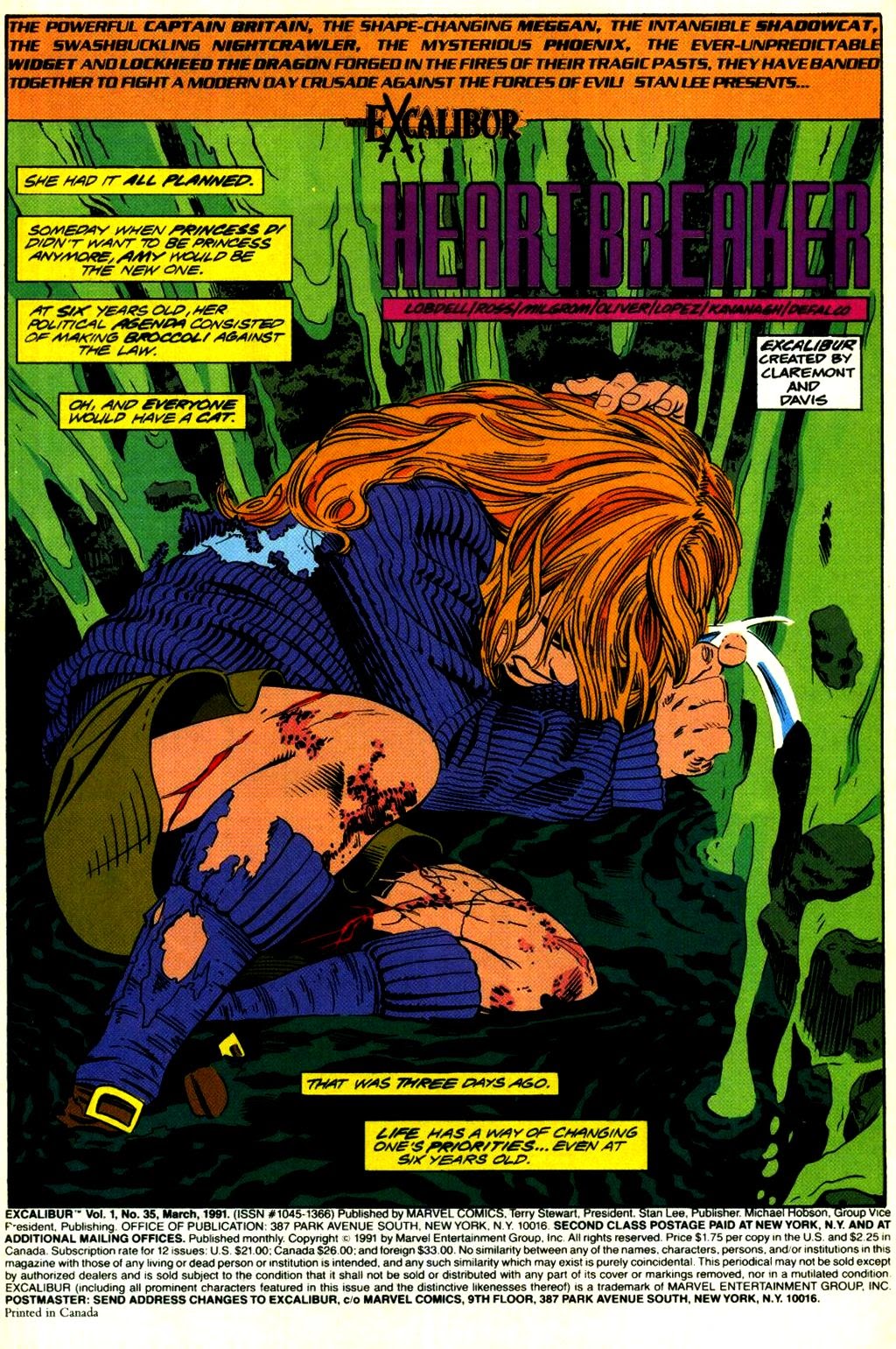Excalibur #35
“Heart-breaker”
Writer: Scott Lobdell
Pencils: David Ross
Inks: Al Milgrom
Colours: Glynis Oliver
Letters: Ken Lopez
Editor: Terry Kavanagh
Original publication date: March 1991
We’re back! And debating the merits of punchable problems in Excalibur #35, “Heartbreaker,” with comics scholar Dr. Jocelyn Sakal Froese! With their help, we apply a graphic medicine framework to an issue in which a kidnapped girl and a despair-hungry demon named—naturally—D’Spayre force Rachel to revisit her defining trauma (again), with some new and not-always-welcome twists, including the first appearance of Father Kurt Wagner. We talk visualizations of grief, medicalized gazes, and intersections of gender and trauma in a comic we found interesting if not always good.
*Note: We had a few sound issues on Mav’s channel in this episode. We did our best to clean it up and appreciate your patience!

On tonal shifts:
On tonal shifts: “Lobdell’s embrace of the grim-dark 90s is kind of frustrating for Excalibur specifically. And I think there’s a fundamental question there. Is Excalibur a group of superheroes who operate out of Britain? Or is Excalibur a particular style or tone or themes? Because we’ve gone from ‘Girls School from Heck’ to Mystic River from one issue to the next. And that is genuinely jarring.” -Andrew

On Graphic Medicine:
On Graphic Medicine: “Graphic medicine scholars emphasize the multimodal nature of comics and the visual representation of an avatar that’s a person but not exactly a person; representations that aren’t photo-realist sometimes make it easier to identity across lines of things like gender, and race, and class. In these ways, comics are great at fostering empathy between text and reader.” -Jocelyn

On gendered trauma:
“Intentionally or not, this comic lets us reflect on the ways certain kinds of trauma are just expected for girls and women. We see it in the world and we see it in popular culture. We’re told that gendered violence and trauma are just part of ‘coming-of-age’ for women.” -Jocelyn

On bodily metaphors:
“Everything about Rachel – her body, her costume, her powers – is in conversation with her trauma. She has to get into her costume telekinetically – there’s no zipper. It’s super-tight and taken from her time as a hound; it symbolizes freedom and restriction.” -Anna

More bodily metaphors:
“Rachel is telepathic and telekinetic. She hosts the Phoenix Force. She can literally reshape reality and raise the dead. Yet she’s often been shown to have very little control over her own body.” -Anna

On the absence of therapy:
“In isolation, this could be a cool story about resilience in the face of depression. But Rachel exists in a universe that has therapy. That has psychopharmacology. So the continual repetition of her trauma minus therapy can also become a statement about how getting help is antithetical to being a superhero.” -Andrew

On the power/danger of simplicity:
“Reducing complex social and personal problems to punchable problems is obviously something superhero comics excel at. It can be very powerful. It can also be dangerous. Making despair a physical problem lets Rachel ‘defeat’ it. It also makes her vulnerable.” -Anna

On symbolism in dreams:
“The little girl has the bomb under her skirt. It didn’t have to be there; that was a choice. And I wasn’t sure what to make of that. But it made me think of the ways violence is sexualized in this comic and the thematic link between Amy and Rachel.” -Jocelyn

On Nightcrawler becoming a priest:
“There’s a huge difference between being Catholic and being a Catholic priest. The first is the personal practice of faith. The second involves becoming a representative of a religious institution. And many of the official policies of the Catholic church as an institution are at odds with Kurt’s established core values.” -Anna

And the pod recruits a new fan (of Rachel, at least!):
Anna: “It will interest you to know that Rachel is a heavily queer-coded character.”
Jocelyn: “That doesn’t surprise me at all. It’s the blazer.”

Want more Jocelyn Sakal Froese?
Check out their recent essay for Inks, “Lateral Moves and Ghostly Gay Children: Queer Spatial Metaphors in Alison Bechdel’s Fun Home.”
And! Check out their essay “Making Space for Making Space: Jeff Lemire’s Essex County and the Canadian Alternative,” in the edited collection The Canadian Alternative.
Plus! Read their essay in Girlhood Studies, “Fantasies of the Good Life: Responding to Rape Culture in 13 Reasons Why,” co-written with Cameron Greensmith.
Or for something that’s great and not academic paywalled: check out their essay for Women Write About Comics, “Nicole Georges’ ‘Calling Dr. Laura,’ Alison Bechdel’s ‘Fun Home,’ Graphic Memoir, and Something Strange About Time.”
Also mentioned on the pod: Bart Beaty’s fabulous (and very engaging and accessible!) book on Archie comics, Twelve-Cent Archie.
And if you want to learn more about Graphic Medicine, check out graphicmedicine.org for reviews, recommendations, and other resources!
And as usual:
You can find Anna on Twitter (@peppard_anna) and on her podcast with Andrew and Michael Hancock, Three Panel Contrast (@3PanelContrast).
You can find Andrew on Twitter (@ClaremontRun).
You can find Mav on Twitter (@chrismaverick) and on his podcast, VoxPopcast (@VoxPopcast).
Enjoy!
-GGW Team


